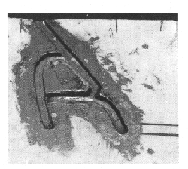
Since the introduction of neon glassbending at the beginning of this century little has changed.It was therefore only a matter of time before some enlightened souls came up with an innovative idea for mass production of P.O.S and beer signs. During Sign Italy a jig bending competition was organized by Tecnolux. The amount of Italian glassblowers that crowded the stand trying to get a look at the action was above expectation,and the competition became quite interesting. During the three days of the exibition many highly talented neon glassblowers attempted to master this new technique. By carefully and thoughtfully watching the contracted American benders Matthew Thompson and Jed Schleisner, several members of the public gathered enough courage to have a try. Most attempts (as expected) failed miserably but there were a couple of individuals who managed to produce something resembling a neon letter.
The Jig
For small series, up to a few 100, the jig is made of a sort of compressed paper which is produced in sheets similar to plasterboard as used in the building industry.The thickness of material used for the jig must be the same as the diameter of the glass that is used for the neon letter. By covering the completed jig with a thin layer of epoxy it's life may be lengthened by a factor 10.The letter form is machined out of the material in a mirror image (such as a neon drawing is made in mirror image)and coated with a graphite solution to prevent hot glass sticking to the jig.
Glass Type
The most used type of glass is lead glass with a UC of 94-95 and wall thickness of 1.2 to 1.3mm. As this glass has thicker walls than other types of glass, it stays warm and maleable for a longer period of time. This glass comes in lengths of 120-150cms and is marginally more expensive than SodaLime glass.
Glass Diameter
The ideal glass diameter is 8,9 and 10mm, also 11 and 12mm glass can be used for larger letters but much of the advantage of speed is lost due the extra time needed in reheating the glass during fabrication of the neon letter.
The chalk markings
The glass tube is marked with chalk in three places.

Marks are also made on the jig and can be seen as three black marks on the above edge of the jig. The two outside marks show the amount of glass to be heated and the last mark shows where the glass is laid into the jig. This manner of glass bending also allows one electrode to be welded to the tube before work begins - saving time.
The burner
Only the ribbon burner is used as the glass has to be heated over a considerable length to enable the corners and returns to be bent in one go. The Hyde Ribbon Burner with a built in blower seems to be the most suited for jig bending and is used by all jig benders. With instruction and (much) practice up to 2 bends and 2 returns can easily be laid and blown at one time. Air is blown into the tube via a swivel and blowhose that is connected to a suitably regulated compressor. Burners using oxygen are unsuitable as the high flame temperature damages the powder layer which forms so called "stains" - something which also occurs when this type of burner is used on coloured glass.
Summary
The demonstration and competition was a big success and discussions are taking place to be able to repeat the show during Sign Germany in Dusseldorf this year. The success could clearly be seen by the amount of people walking around Sign Italy holding a neon letter A or P in their hand. This enormous production is easily achieved as approximately a minute is needed to make a letter. Therefore in one morning a couple of hundred can easily be produced.
This technique is quite suitable for student glass blowers as it does not require a high level of skill. Therefore a company that employs a student can expect some production and not only full rubbish containers.
Alas, there were no participants from the Low Countries except a colleague and his son from the city of Leyden that both enjoyed a day in North Italy with of course the necessary fluid meals.
extracted in part and translated from:
Sign.txt - february 1995